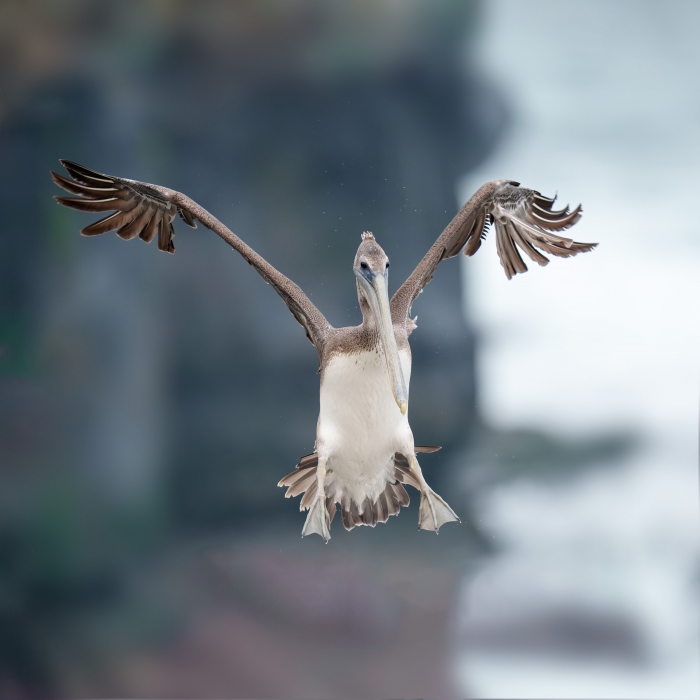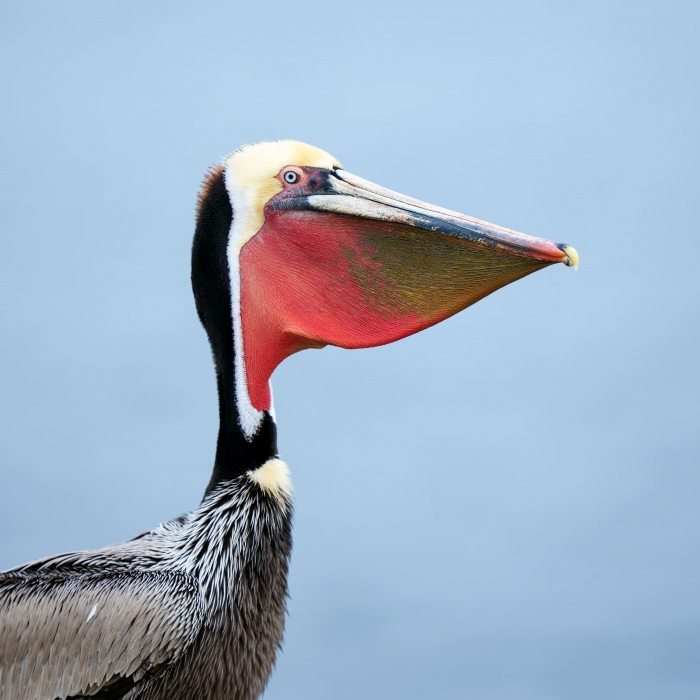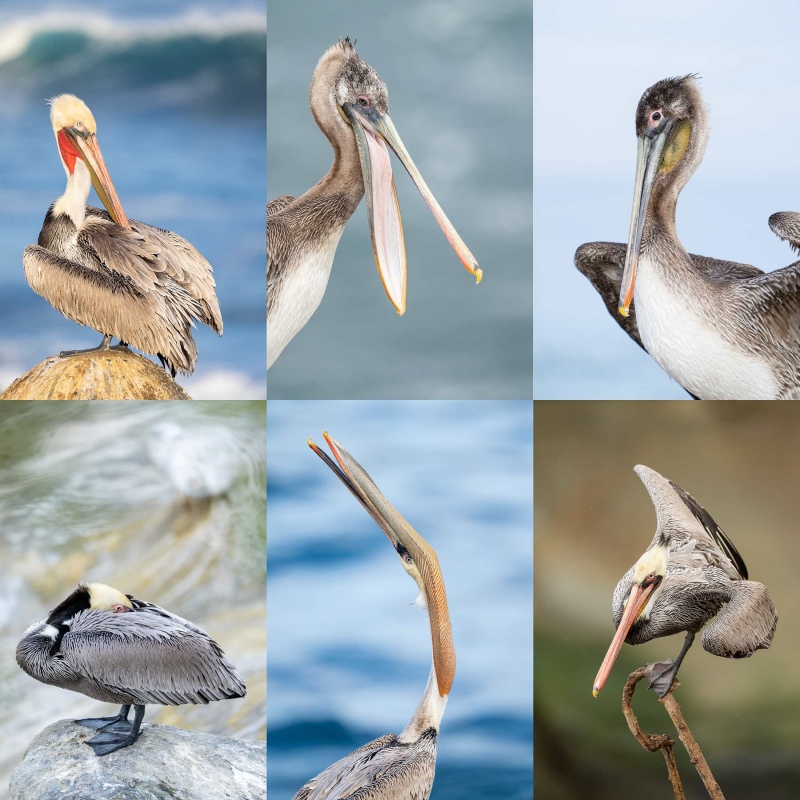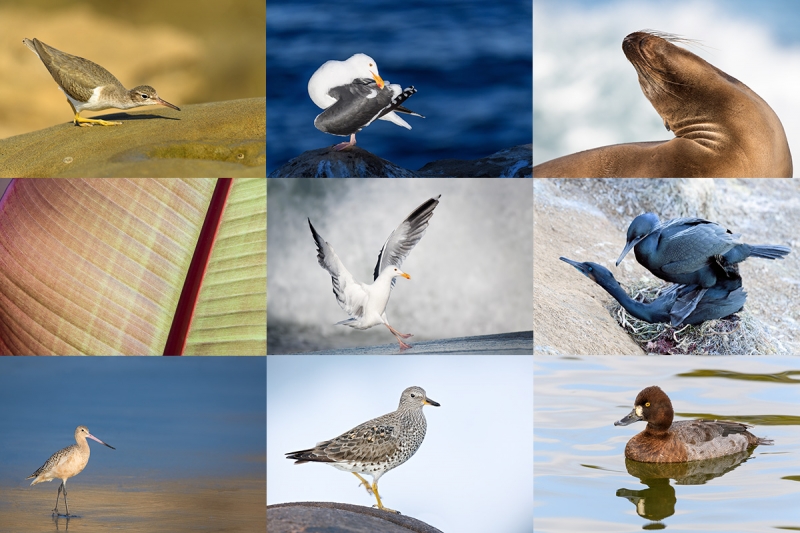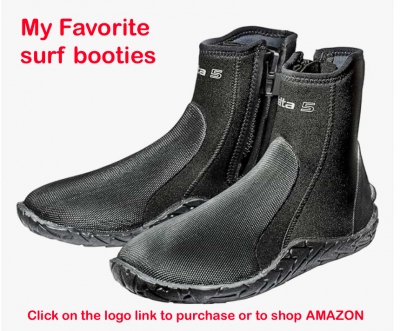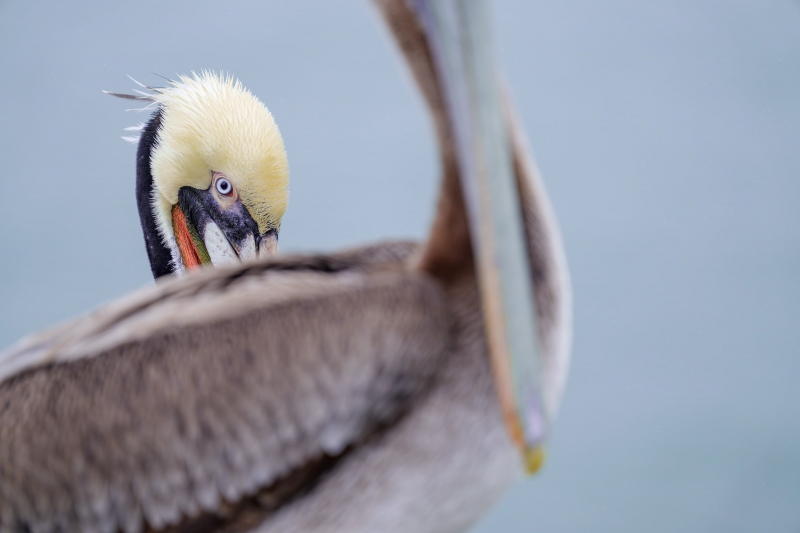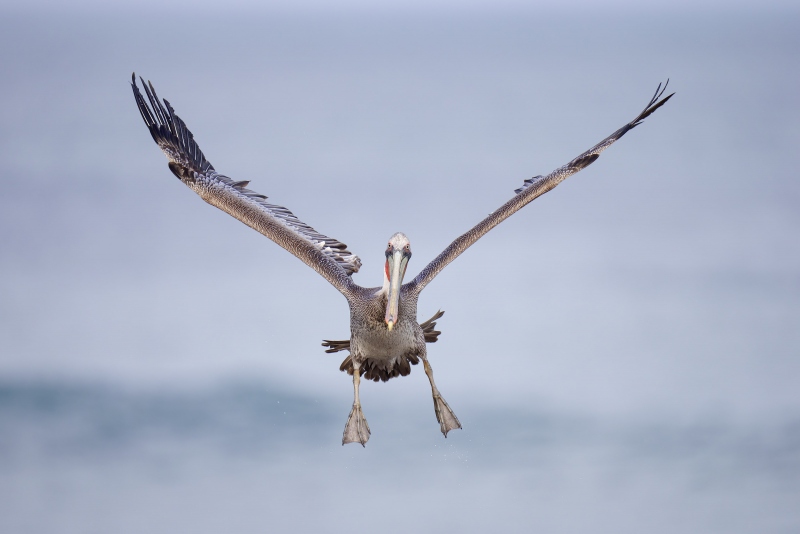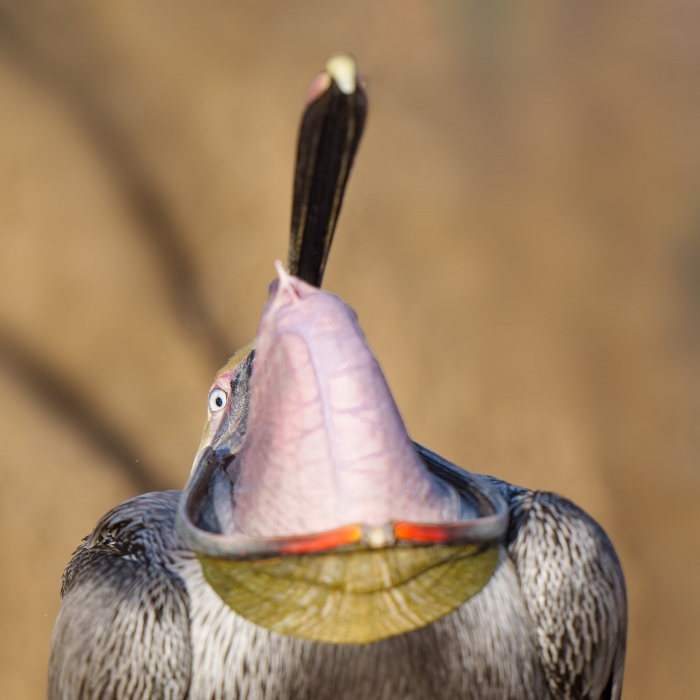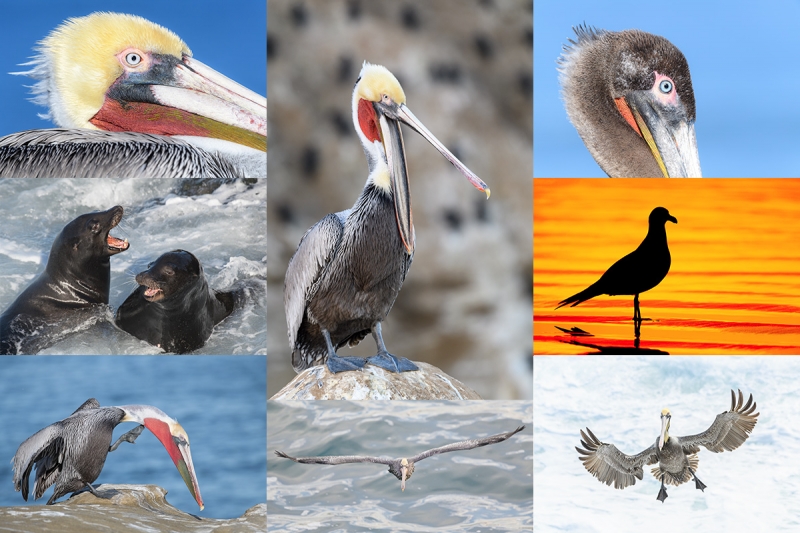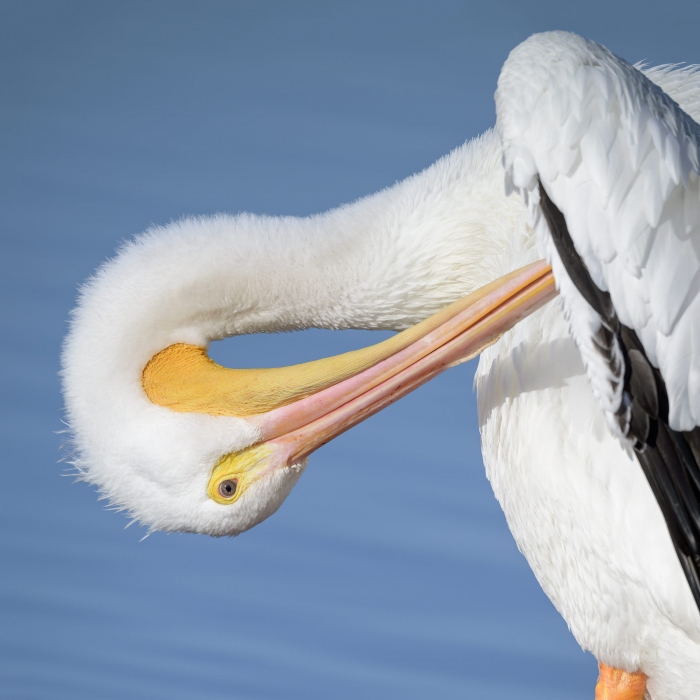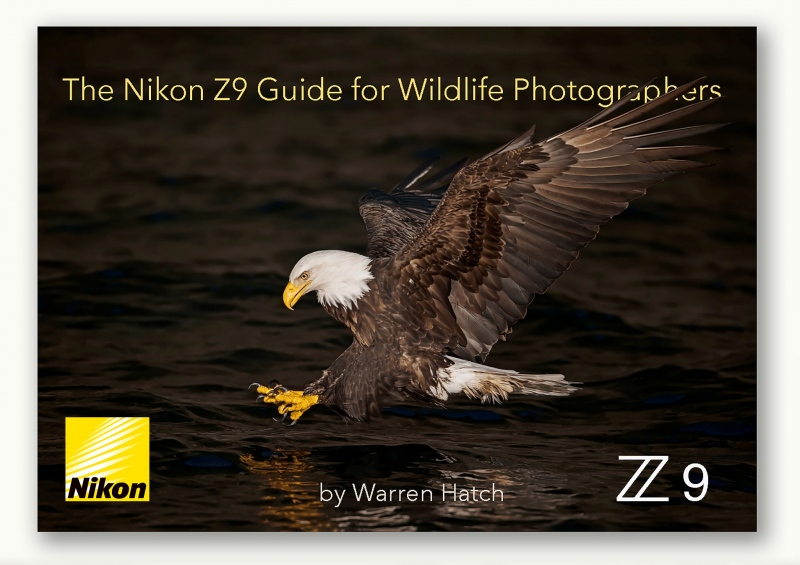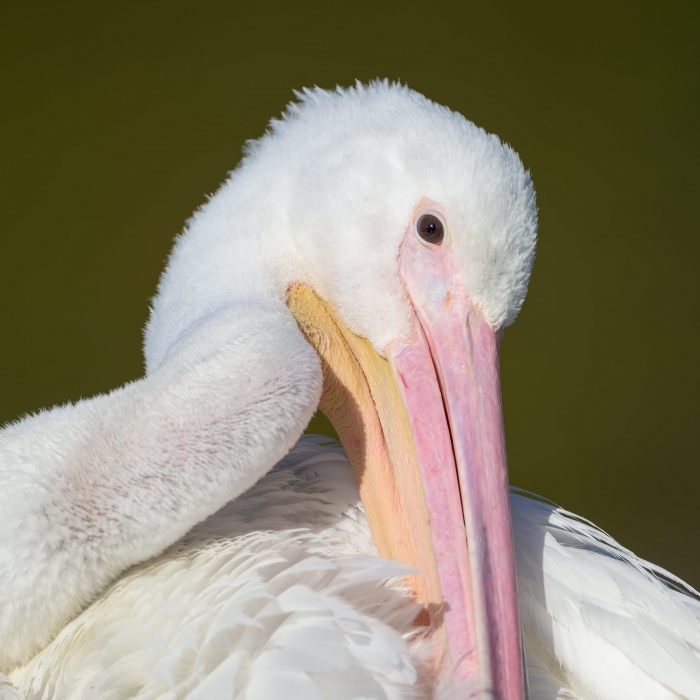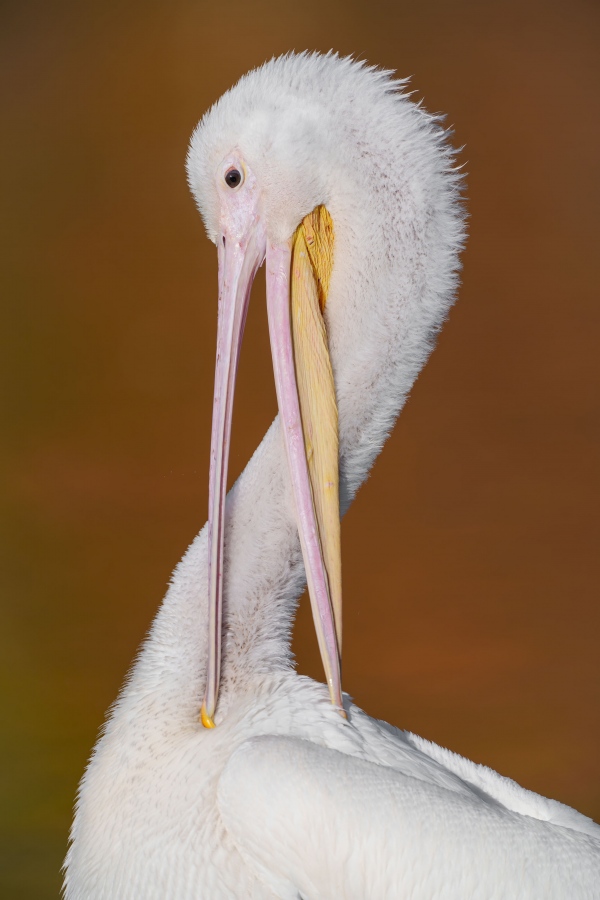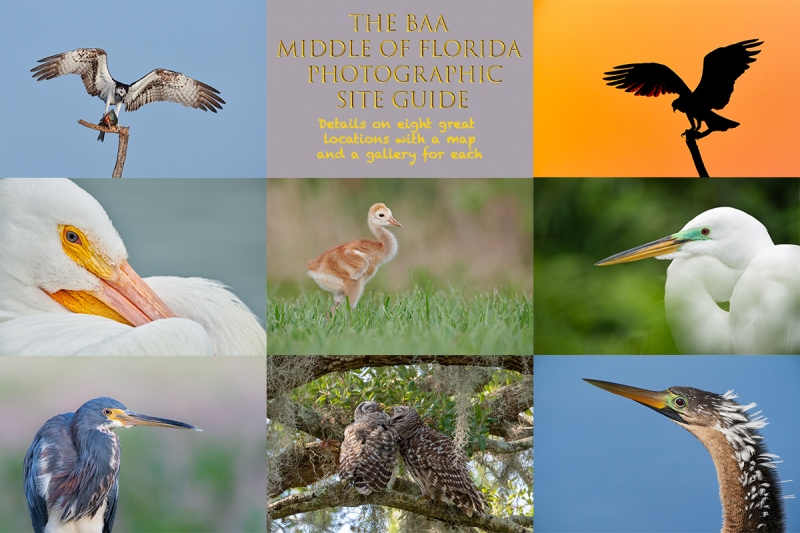January 18th, 2024 This Just In: 1/18/2024 — 12:16pm Pacific Time
Not too late to join me in San Diego …
Thursday morning at La Jolla was beyond spectacular. In perfect conditions, I created 3460 images. Now all I need to do is pick the best ones. But first, a nap.
What’s Up?
I did a bit of photography on Wednesday morning and took a long scouting walk. Of yesterday’s three images, my favorite was Image #3, the bill pouch cleaning. Nobody liked any of the images. Sorry to Sue, she does not count. She always likes all of them but the silhouettes that she feels are “too dark.”) All the rest are “well made and interesting.” Many folks have kindly tried to explain to her what a silhouette is but she ain’t having it.
In the previous post, the golden brown background was my favorite.
Wherever you are and whatever you choose to do, I hope that you too have a great day. My late Mom would not be shocked to learn that I am headed out early to photograph pelicans! If you are interested in joining me for an In-the-Field Instructional Session in San Diego this month, please get in touch ASAP either via e-mail or by calling or texting my cell at 863-221-2372. I was thrilled to learn recently that two folks signed up for San Diego #2. Both are first timers: Jeanette LaPorte and Tom Baker. It is not tool late to sign up for either IPT and be ensured of almost private instruction. Get in touch as above to learn of the couples or late registration discounts.
Please remember to use the B&H links that are found on most blog pages and to use the BIRDSASART discount code at checkout when purchasing your new gear from Bedfords to get 3% back on your credit card and enjoy free second-day air FedEx. Please, also, consider joining a BAA IPT. You will be amazed at how much you will learn!
If an item — a Delkin flash card, or a tripod head — for example, that is available from B&H and/or Bedfords, is also available in the BAA Online Store, it would be great, and greatly appreciated, if you would opt to purchase from us. We will match any price. Please remember also to use my B&H affiliate links or to earn 3% cash back at Bedfords by using the BIRDSASART discount code at checkout for your major gear purchases. Doing either often earns you free guides and/or discounts. And always earns my great appreciation.
If …
If you have a question about this image, please leave a comment.
|
|
|
This image was created on 17 January 2024 on the cliffs at La Jolla. Standing at full height, I used the Robus RC-5558 Vantage Series 3 Carbon Fiber Tripod/Levered-Clamp FlexShooter Pro-mounted Sony FE 400mm f/2.8 GM OSS lens and The One, the Sony Alpha 1 Mirrorless Digital Camera). The exposure was determined via Zebra technology with ISO on the Thumb Dial. ISO 2000. 1/2500 sec. at f/2.8 (wide open) in Manual mode. When evaluated in RawDigger, the raw file exposure was determined to be dead-solid perfect (ho hum). AWB at 7:53:13am on cloudy morning.
Tracking: Zone/AF-C with Bird Face/Eye detection enabled performed to perfection. Be sure to click on the image to enjoy a high-res version.
Image #2: Brown Pelican breeding plumage Pacific race with bill pouch distended right after head throw
|
If …
If you have a question about this image, please leave a comment.
|
|
|
San Diego offers a wealth of very attractive natural history subjects, including and especially the Pacific race of California Brown Pelican. With annual visits spanning more than four decades, I have lots of photographic experience there … Click on the composite to enjoy a larger version.
|
Learning Exposure, Whether You Like It Or Not
Whether you like it or not, we will be beating the subject of exposure like a dead horse. In every new situation, you will hear my thoughts on exposure along with my thoughts on both Nikon and Canon histograms and SONY Zebras. Whether you like it or not, you will learn to work in manual mode so that you can get the right exposure every time (as long as a bird gives you ten seconds with the light constant). Or two seconds with SONY zebras … And you will learn what to do when the light is changing constantly. What you learn about exposure will be one of the great takeaways on every IPT.
|
|
|
Though the pelicans will be the stars of the show on this IPT, there will be many other handsome and captivating subjects in wonderful settings. Click on the composite to enjoy a larger version.
|
It Ain’t Just Pelicans
With gorgeous subjects just sitting there waiting to have their pictures taken, photographing the pelicans on the cliffs is about as easy as nature photography gets. With the winds from the east almost every morning, there is usually some excellent flight photography, at times with 70-200mm lenses! And the pelicans are almost always doing something interesting: preening, scratching, bill pouch cleaning, or squabbling. And then there are those crazy head throws that are thought to be a form of intra-flock communication. You will be guided as to how to make the best of those opportunities. Depending on the weather, the local conditions, and the tides, there are a variety of other fabulous photo chances available in and around San Diego. Each IPT will include one or two duck sessions.
|

|
|
Did I mention that there are lots of great birds and natural history subjects in San Diego in winter? Click on the composite to enjoy a larger version.
|
The San Diego Details
These IPTs will include four or five 3-hour morning photo sessions, three or four 1 1/2-hour afternoon photo sessions, and three or four working brunches that will include image review and Photoshop sessions. On rare cloudy days, we may — at the leader’s discretion, stay out in the morning for a long session and skip that afternoon shoot. To ensure early starts, breakfasts will be your responsibility. And so that we can get some sleep, dinners will be on your own as well. In the extremely unlikely event that Goldfish Point is closed due to local ordinance (or whimsy) — that has never happened in the past fifty years, I will of course do my very best to maximize our photographic opportunities.
Deposit Info
A $699 deposit is required to hold your slot for one of the 2024 San Diego IPT. You can send a check (made out to “BIRDS AS ART”) to us here: BIRDS AS ART, PO Box 7245, Indian Lake Estates, FL, 33855, or call Jim or Jennifer at the office with a credit card at 863-692-0906. Your balance, payable only by check, is due three months before the trip.
|

|
|
Variety is surely the spice of life in San Diego. Click on the composite to enjoy a larger version.
|
Getting Up Early and Staying Out Late
On all BIRDS AS ART IPTS including and especially the San Diego IPT, we get into the field early to take advantage of unique and often spectacular lighting conditions and we stay out late to maximize the chances of killer light and glorious sunset silhouette situations. We often arrive at the cliffs a full hour before anyone else shows up to check out the landscape and seascape opportunities.
Typos
With all blog posts, feel free to e-mail or to leave a comment regarding any typos or errors.
January 17th, 2024 Amazon
In it’s infinite wisdom, the Amazon affiliate program recently eliminated all types of generic and logo links as well as product-specific links such as those formerly featured on the Great (Photographic Accessory) Stuff tab here (and above on the orange-yellow menu bar).
On this and most future blog posts, I will post an item that contains my Amazon Affiliate link. If you do not wish to purchase the item, you can help support the work that I do here by clicking on the link and then continuing to shop. Please consider making it a habit of visiting the blog before you do your Amazon shopping online. Great news: it will not cost you a penny more, works great with your Amazon Prime or Amazon Business accounts, and will be gratefully appreciated.
When I might need to be walking in the water be it at Fort DeSoto, La Jolla Shores Beach, Nickerson Beach, or anywhere else, I always have a pair of surf booties on. The are comfortable, add a bit of warmth on cold days, keep your feet cool on warm days, prevent cuts from shells, broken glass, and the like, and give some degree of protection against sting rays.
I’d advise the 3mm thickness if you will be walking in warm water, or the 5mm thickness for cold water.
You can order a pair of surf booties by clicking here. They tend to run a bit small. I wear mine with socks. You do not need split toe booties.
Your Call?
Which of today’s three featured images is your favorite? All are invited to leave a comment letting us know why they made their choice. I will share my fave here soon.
Save Flying Tip
Whenever I fly, I make sure to tip the bathroom attendant in the airport. I do it for good luck. So far, I have a perfect record of safe flights. If the plane crashes, the two bucks will not do me any good anyway!
What’s Up?
A day late by not a dollar short, I flew to San Diego on the afternoon Alaska Airlines non-stop from Orlando. I picked up my rental car and headed to my AirBnB in Clairmont Mesa. I was in bed by 9pm 🙂
Wherever you are and whatever you choose to do, I hope that you too have a great day. My late Mom would not be shocked to learn that I am headed out early to photograph pelicans! If you are interested in joining me for an In-the-Field Instructional Session in San Diego this month, please get in touch ASAP either via e-mail or by calling or texting my cell at 863-221-2372. I was thrilled to learn recently that two folks signed up for San Diego #2. Both are first timers: Jeanette LaPorte and Tom Baker. It is not tool late to sign up for either IPT and be ensured of almost private instruction. Get in touch as above to learn of the couples of late registration discounts.
Please remember to use the B&H links that are found on most blog pages and to use the BIRDSASART discount code at checkout when purchasing your new gear from Bedfords to get 3% back on your credit card and enjoy free second-day air FedEx. Please, also, consider joining a BAA IPT. You will be amazed at how much you will learn!
If an item — a Delkin flash card, or a tripod head — for example, that is available from B&H and/or Bedfords, is also available in the BAA Online Store, it would be great, and greatly appreciated, if you would opt to purchase from us. We will match any price. Please remember also to use my B&H affiliate links or to earn 3% cash back at Bedfords by using the BIRDSASART discount code at checkout for your major gear purchases. Doing either often earns you free guides and/or discounts. And always earns my great appreciation.
|
|
|
This image was created on 3 January 2023 on the cliffs at La Jolla. Standing at full height, I used the handheld Sony FE 70-200mm f/2.8 GM OSS II lens with the Sony FE 1.4x Teleconverter (at 280mm) and The One, the Sony Alpha 1 Mirrorless Digital Camera.. The exposure was determined via Zebras with ISO on the Thumb Dial. ISO 1250: 1/2500 sec. at f/4 (wide open) in Manual mode. When evaluated in RawDigger, the raw file brightness was determined to be perfect. AWB at 9:51:30am on a cloudy drizzly morning.
Tracking: Expand Spot/AF-C with Bird-Eye/Face Detection performed perfectly. Click on the image to enjoy a high-res version.
Image #1: Brown Pelican Pacific race adult looking over the back of a juvenile
|
Float or Sink?
Does Image #1 float your boat or would it be an insta-delete for you? Note — this was not a photobombing; I got just what I was after.
Tip
In situations like this, whatever system you are using, you will surely want to avoid using any type of Zone AF pattern or method. Sony’s tracking with Expand Spot is so good that I will only rarely move the AF point around the frame as needed. I can start with the point in the middle — the system will continue to track the eye of the bird in the rear as I move the lens to re-compose. Most systems will have something similar.
Killer for Flight
It is hard to believe that I was dead-set again the 400mm f/2.8 lens for so many decades. Now, I handhold mine often for flight and action, especially in spots where the birds are relatively tame like La Jolla and Fort DeSoto.
In Image #2 I like that the breaking wave crossed the frame at the bird’s feet. If it had cut the bird’s head or body that would have been far less pleasing.
Of Note
First, note that even though I was using f/2.8, the wide-open aperture, the entire bird is sharp from the bill tip to the wing tips.
Second, note that the super-wide f/2.8 aperture allowed for a very fast shutter speed at a reasonable ISO despite the relatively low light situation. I can’t wait for the Sony 300mm f/2.8 to ship!
Bill Pouch Cleaning
Pacifc-race Brown Pelicans seem to clean their bill pouches far more often than the pelican in Florida. Usually — but not always — while sitting down, they will lean their head back and pull the bill pouch over their folded neck while opening the bill. This is often an indication that a dramatic head throw is next.
Tracking: Expand Spot was the ticket to success as it did an excellent job of tracking the bird’s right eye. The AF point was actually a fraction of an inch above and a fraction of an inch to the right of the bird’s eye. At 12 meters, the total depth of field at f/8 at 800mm was 2.75 inches, well more than enough to cover the eye. As for the bill tip, you pretty much have to forget about it. An aperture of f/32 would yield a total dof of 15 inches, but utilizing that would be quite tricky.
|
|
|
San Diego offers a wealth of very attractive natural history subjects, including and especially the Pacific race of California Brown Pelican. With annual visits spanning more than four decades, I have lots of photographic experience there … Click on the composite to enjoy a larger version.
|
The 2024 San Diego Brown Pelicans (and more!) IPTs
San Diego IPT #1: 4 1/2 DAYS: TUES 23 JAN thru the morning session on SAT 27 JAN 2024: $2699.00. Deposit: $699.00. Limit: 6/Openings 4.
San Diego IPT #2: 3 1/2 DAYS: WED 31 JAN thru the morning session on SAT 3 FEB, 2024: $2149.00. Limit: 6 photographers/Openings 4.
Please e-mail for information on personalized pre- and post-IPT morning sessions.
Join me in San Diego to photograph the spectacular breeding plumage Brown Pelicans with their fire-engine red and olive green bill pouches; Brandt’s (nesting) and Double-crested Cormorants; breeding plumage Wood and Ring-necked Ducks; other duck species possible including Lesser Scaup, Redhead, Northern Shoveler and Surf Scoter; a variety of gulls including Western, California, and the gorgeous Heermann’s, all in full breeding plumage; shorebirds including Marbled Godwit, Willet, Sanderling and Black-bellied Plover; many others are possible including Least, Western, and Spotted Sandpiper, Whimbrel, Black and Ruddy Turnstone, Semipalmated Plover, and Surfbird; Harbor Seals and California Sea Lions (both depending on the current regulations and restrictions). And as you can see by studying the IPT cards, there are some nice bird-scape and landscape opportunities as well. Not to mention a ton of excellent flight photography opportunities and instruction.
I discovered some really neat new spots on my 2022/23 visit. As a result, the first and second IPTs may include an afternoon or two of landscape photography.
Please note: where permitted and on occasion, ducks and gulls may be attracted (or re-located) with offerings of grains or healthy bread.
|
|
|
San Diego offers a wealth of very attractive natural history subjects, including and especially the Pacific race of California Brown Pelican. With annual visits spanning more than four decades, I have lots of photographic experience there … Click on the composite to enjoy a larger version.
|
Learning Exposure, Whether You Like It Or Not
Whether you like it or not, we will be beating the subject of exposure like a dead horse. In every new situation, you will hear my thoughts on exposure along with my thoughts on both Nikon and Canon histograms and SONY Zebras. Whether you like it or not, you will learn to work in manual mode so that you can get the right exposure every time (as long as a bird gives you ten seconds with the light constant). Or two seconds with SONY zebras … And you will learn what to do when the light is changing constantly. What you learn about exposure will be one of the great takeaways on every IPT.
|
|
|
Though the pelicans will be the stars of the show on this IPT, there will be many other handsome and captivating subjects in wonderful settings. Click on the composite to enjoy a larger version.
|
It Ain’t Just Pelicans
With gorgeous subjects just sitting there waiting to have their pictures taken, photographing the pelicans on the cliffs is about as easy as nature photography gets. With the winds from the east almost every morning, there is usually some excellent flight photography, at times with 70-200mm lenses! And the pelicans are almost always doing something interesting: preening, scratching, bill pouch cleaning, or squabbling. And then there are those crazy head throws that are thought to be a form of intra-flock communication. You will be guided as to how to make the best of those opportunities. Depending on the weather, the local conditions, and the tides, there are a variety of other fabulous photo chances available in and around San Diego. Each IPT will include one or two duck sessions.
|

|
|
Did I mention that there are lots of great birds and natural history subjects in San Diego in winter? Click on the composite to enjoy a larger version.
|
The San Diego Details
These IPTs will include four or five 3-hour morning photo sessions, three or four 1 1/2-hour afternoon photo sessions, and three or four working brunches that will include image review and Photoshop sessions. On rare cloudy days, we may — at the leader’s discretion, stay out in the morning for a long session and skip that afternoon shoot. To ensure early starts, breakfasts will be your responsibility. And so that we can get some sleep, dinners will be on your own as well. In the extremely unlikely event that Goldfish Point is closed due to local ordinance (or whimsy) — that has never happened in the past fifty years, I will of course do my very best to maximize our photographic opportunities.
Deposit Info
A $699 deposit is required to hold your slot for one of the 2024 San Diego IPT. You can send a check (made out to “BIRDS AS ART”) to us here: BIRDS AS ART, PO Box 7245, Indian Lake Estates, FL, 33855, or call Jim or Jennifer at the office with a credit card at 863-692-0906. Your balance, payable only by check, is due three months before the trip.
|

|
|
Variety is surely the spice of life in San Diego. Click on the composite to enjoy a larger version.
|
Getting Up Early and Staying Out Late
On all BIRDS AS ART IPTS including and especially the San Diego IPT, we get into the field early to take advantage of unique and often spectacular lighting conditions and we stay out late to maximize the chances of killer light and glorious sunset silhouette situations. We often arrive at the cliffs a full hour before anyone else shows up to check out the landscape and seascape opportunities.
Typos
With all blog posts, feel free to e-mail or to leave a comment regarding any typos or errors.
January 15th, 2024 Via Text from Sigmon Whitener
Sadako and I had a great time with you on the 2 1/2-DAY DeSoto IPT. And, in just a couple of days, we learned a lot more than we ever expected to.
Your Call?
Which of the three background colors do you prefer for a preening white pelican?
These Just About Sum It Up
Keith Solberg: January 13, 2024 at 6:40pm
I like the bird’s pose. The rocks are OK, but IMO they might be better if they were roughly the same height. The extra height on the right upsets the image’s balance for me.
with love, a
Arthur Morris/BIRDS AS ART: January 13, 2024 at 11:11pm
Thanks for leaving a comment, Keith. For me, the extra height of the rocks on the right balance’s the image perfectly. And just for the record books, I think that it is a fantastic image.
Cliff Beittel: January 14, 2024 at 7:53pm
Agree about the height of the rocks on the right–bird seems positioned perfectly against the background. The background has a desert look–like Joshua Tree NP without the trees. Not a negative, just different and interesting.
Arthur Morris/BIRDS AS ART: January 15, 2024 at 7:08am
Thanks, Cliff. The ambience under the bridge is not very pleasing :-).
As I was making that image, I thought, “I am not gonna like those rocks — they are too close to the bird.” I was happy that the super-wide f/2.8 aperture blurred them so nicely.
with love, a
What’s Up?
I learned on Saturday morning that Alaska Airlines had cancelled my nonstop Monday afternoon flight from Orlando to San Diego as the airline was forced to ground many Boeing 737 Max 9 flights after last week’s mid-air cabin panel blowout. (You can learn about the FAA investigation here.) I called the airline and looked into new flights for Monday. I went with one where I’d have to leave Orlando more than two hours earlier, layover at DFW for two hours, and arrive in San Diego at about the same times as originally planned.
But when the Buffalo Bills/Pittsburgh Steelers game (go Bills!) was moved from Sunday to Monday, I decided that I did not want to miss that game and the Philadelphia Eagles/Tampa Bay Buccaneers (go Bucs!) as well. So I looked for a flight on Tuesday and found a nonstop from MCO to SAN. I called Alaska on Saturday evening, but with so many cancellations and delays because of the grounded aircraft and the frigid weather and snow, the recording said, “The longest wait time to speak to an agent is five hours.” I went to bed.
I woke at 5:30am on Sunday and figured that if I called then, I could quickly change my flight. I got a message stating: “The longest wait time to speak to an agent is six hours.” With no choice, I plugged my cell phone in and waited on hold. I did get lots of work done making sure that I took the phone with me when I left my office. After two hours twenty minutes, a pleasant agent answered and changed my flights in a very few minutes. I will be flying to San Diego nonstop on Tuesday afternoon.
I’ve been flying Alaska a lot recently and honestly say that they have fantastic customer service. All of my flights have been pleasant and all of my luggage has arrived on time — knock on wood …
Today is Monday 15 January 2024. I will continue packing for my 4-week CA trip. Wherever you are and whatever you choose to do, I hope that you too have a great day.
Please remember to use the B&H links that are found on most blog pages and to use the BIRDSASART discount code at checkout when purchasing your new gear from Bedfords to get 3% back on your credit card and enjoy free second-day air FedEx. Please, also, consider joining a BAA IPT. You will be amazed at how much you will learn!
If an item — a Delkin flash card, or a tripod head — for example, that is available from B&H and/or Bedfords, is also available in the BAA Online Store, it would be great, and greatly appreciated, if you would opt to purchase from us. We will match any price. Please remember also to use my B&H affiliate links or to earn 3% cash back at Bedfords by using the BIRDSASART discount code at checkout for your major gear purchases. Doing either often earns you free guides and/or discounts. And always earns my great appreciation.
|
|
|
This image was created at Lakeland, FL on 10 January by Sigmon Whitener on a 2 1/2-DAY Fort DeSoto private IPT. He used a RWS monopod/Wimberley MonoGimbal Head-mounted Nikon NIKKOR Z 800mm f/6.3 VR S Lens with the Nikon Z9 Mirrorless Camera. ISO 400: 1/1250 second at f/8 in Manual mode. At 8:56:43 on a sunny morning.
Image optimization and how-to video by Arthur Morris/BIRDS AS ART
Image #1: American White Pelican preening
Image courtesy of and copyright 2023: Sigmon Whitener
|
Change of Plans
Leery of the forecast on Wednesday morning, I suggested that we detour and head for Lakeland and the white pelicans instead of walking North Beach at Fort DeSoto in a northwest wind. Sigmon and Sadako agreed. There were about two dozen of the big birds lined up on their favorite bulkhead. It turned out to be a fabulous morning.
The two cameras are virtually identical. As the Z8 does not have the built-in battery grip, it is physically smaller and weighs almost a full pound less — the Z8 is 2.0 pounds with a battery and a flash card as compared to 2.9 pounds for the Z9. The Z8 costs exactly $1500 less. AF performance and the image quality are identical, both of course are dependent on the skill of the operator.
Unless you have a problem with its smaller body size and the lack of a vertical grip, the Z8 would be the way to go. If I were shooting Nikon, I’d be using a Z8.
If you are a Nikon user who can add any relevant info here, please leave a comment sharing what you know.
|
|
|
You can purchase your copy here in the BAA Online Store for $69.00. Or Call Jim weekdays at 863-692-0906 with a credit card in hand.
The Nikon Z9 Guide for Wildlife Photographers
|
The Nikon Z9 Guide for Wildlife Photographers/by Warren Hatch — Editorial Consultant: Arthur Morris
Updated for Firmware V4.0
In this downloadable e-book (you will receive a link by e-mail), you’ll learn everything a wildlife photographer needs to know about the Nikon Z9. The Z9 is one of the most complex camera bodies ever made. In this guide, the brilliant Warren Hatch will teach you exactly how to set up your Z9 for bird, wildlife, and nature photography. The camera offers hundreds of settings and options. Selecting the right combination of these is essential in order to effectively use the Z9 in the field.
This 83-page guide, created in the tradition of the many mega-successful BIRDS AS ART Camera User’s Guides, includes:
1- Extensive information on the autofocus system and the optimal settings for the various shooting situations that wildlife photographers encounter including and especially for birds in flight.
2- The camera controls – what they do and how to customize them for your shooting style and varying conditions.
3- Configuring the camera so that you never need to take your eye from the viewfinder when the action unfolds.
5- Insights and details on using legacy F-mount lenses on the Z-9.
6- Practical advice about the camera batteries and chargers.
7- How to take advantage of the new capabilities introduced with firmware v2.00.
8- The AF-area Modes you should use and those you should avoid.
Order yours here in the BAA Online Store for $69.00. Or Call Jim weekdays at 863-692-0906 with a credit card in hand.
Learn more about this great guide in the blog post here.
|
|
|
This image was created at Lakeland, FL on 10 January by Sadako Whitener on a 2 1/2-DAY Fort DeSoto private IPT. She used a RWS monopod/Wimberley MonoGimbal Head-mounted Nikon NIKKOR Z 800mm f/6.3 VR S Lens with the Nikon Z8 Mirrorless Camera. ISO 200: 1/1000 second at f/6.3 in Manual mode. At 8:26:02am on a sunny morning. At 8:26:02am on a sunny morning.
Image optimization and how-to video by Arthur Morris/BIRDS AS ART.
Image #2: American White Pelican preening
Image courtesy of and copyright 2023: Sadako Whitener
|
The Nikon NIKKOR Z 800mm f/6.3 VR S Lens
This Z lens was designed specially for Nikon mirrorless. It weighs only 5.2 pounds. It is somewhat of a hybrid as it is an S series lens with PF (Phase Fresnel) elements. The PF lens element effectively compensates for chromatic aberration and ghosting when combined with ordinary glass lens elements. Utilizing a Phase Fresnel element allows Nikon engineers to use fewer elements. This results in a lighter, more compact lens. Since any movement of the lens when shooting results in unsharpness ( a factor of the square of the focal length), you need to employ good sharpness technique when handholding long lenses like this or using them on a monopod. Both Sigmon and Sadako did well with sharpness.
Yes, and as expected, the Z 800 PF is exceptionally sharp. Having the center of balance well to the rear makes handholding easier for folks who can manage 5-pounders. With this Z lens, you can assign ISO to the Programmable Control Ring on the lens barrel. I was surprised to learn that the control ring operates without click stops, that is, the ISO changes seamlessly. I recommend that everyone using this lens adapt this strategy so that they can quickly and easily change the ISO without having to push and hold a button and then turn a dial. Note that with with all systems, I advise working in Manual Mode, setting the best shutter speed and aperture for the situation, and then controlling the exposure by changing the ISO.
This lens offers full-time manual focus override. This feature enables users to focus manually by turning the focusing ring when the AF system of a mirrorless camera body is temporarily blind. This seeming inexplicable situation is explained in detail in The Art & Science of Photographing Birds in Flight. If I were shooting Nikon, I would surely own and use this lens.
Changing Background Colors in the Field!
Somewhere, sometime long ago, I wrote something to this effect: “It would be great if we could move the elements of an image around in the frame, but that is not possible when photographing free and wild birds. Thus, the only way we can move stuff around in the frame or change the color of the background is to change our perspective.”
The light was sweet and there were several nice background colors to work with:
Sigmon’s blue background in Image #1 was the lake.
Sadako’s green backdrop in Image #2 was the reflection of foliage on the far shoreline.
The orange/gold setting for my Image #3 was the reflection of some fall colors on a large bush.
Note that each of us had to work off sun angle to some degree to get the background color that we wanted.
We all got low when making our images to move the background farther away. But, as is often the case, we could not get too low as that introduced dark elements on the far shoreline.
The lesson: take great care when choosing your perspective.
|
|
The BAA Middle of Florida Photographic Site Guide
You can purchase your copy here in the BAA Online Store.
|
The BAA Middle of Florida Photographic Site Guide
126 pages, 87 photographs by Joe Przybyla and Arthur Morris.
The PDF for this e-Guide is an electronic download sent via e-mail.
Purchase your copy here in the BAA Online Store.
I had thought about doing a guide to some of the great but little-known photo hotspots around central Florida for about a decade, but those plans never came to fruition. I met Joe online in the Avian Forum at BirdPhotographer’s.Net about two years ago. Joe’s photography has improved tremendously over the past few years; he credits the BAA blog, my books and PDFs, and his participation on BPN. The one thing that I learned right from the get-go about Joe is that he is a hard and tenacious worker, always striving to improve his skills and to grow his knowledge base. As he knew of more than a few good spots in central Florida, I broached the idea of us doing a photographic site guide that covered many of the little-known photographic hotspots from Brandon to Lakeland to Joe Overstreet Road to Indian Lake Estates (my Florida home for the past 20 years or so). After more than many, many dozens of hours of effort, The BIRDS AS ART Middle of Florida Photographic Site Guide is now a reality. Thanks to Joe’s wife Dottie for her review of our writing. We all learned once again that writing is a process, a back-and-forth process. All thanks to the white pelicans of Lakeland. Below are the locations that are detailed in this e-Guide. Please note that last season, Gatorland did not offer a Photographer’s Pass.
- Indian Lake Estates: Sandhills Cranes with chicks and colts, lots of vultures, and Ospreys up the kazoo!
- Gatorland, Kissimmee: Learn to make great images of wading birds in a cluttered rookery.
- The Brandon Rookery: Great for nesting Wood Storks, Great Egrets, and more.
- Circle Bar B Reserve, Lakeland: Here you will find a great variety of avian subjects in a great variety of habitats.
- Lake Morton, Lakeland: There are lots of silly tame birds here including and especially American White Pelican during the colder months.
- Lake Mirror, Lakeland: Tame Anhingas, Limpkins, and a zillion White Ibises at times.
- West Lake Parker, Lakeland: Here, if you are lucky, you will have a chance for two difficult birds: Snail Kite, and Purple Gallinule.
- Joe Overstreet Road, Kenansville: Crested Caracara, meadowlarks, Loggerhead Shrike, and much more on the fenceposts and barbed wire.
Each location includes a map, a detailed description of the best spots, best season, light and time of day instructions, the expected species, and an educational and inspirational gallery that is designed to open your eyes as to the possibilities.
You can purchase a copy here in the BAA Online Store.
Typos
With all blog posts, feel free to e-mail or to leave a comment regarding any typos or errors.
|
|

